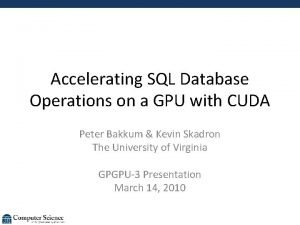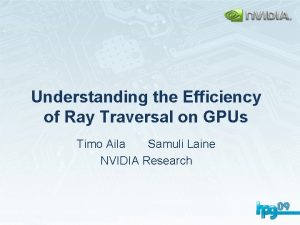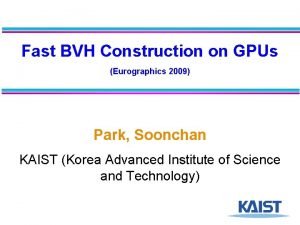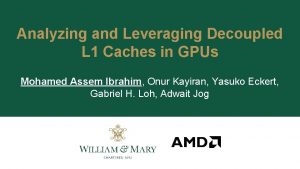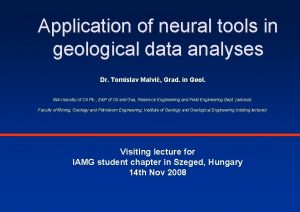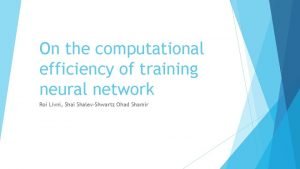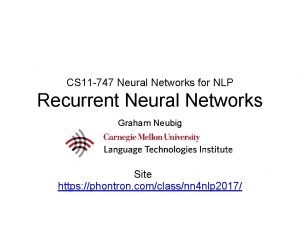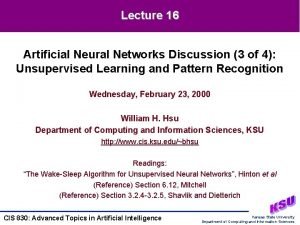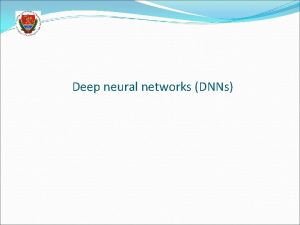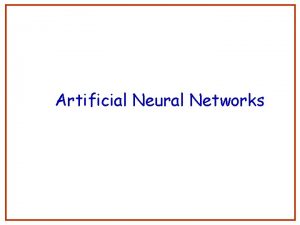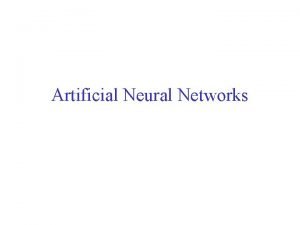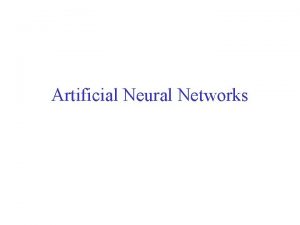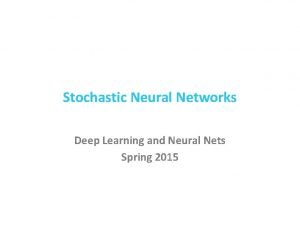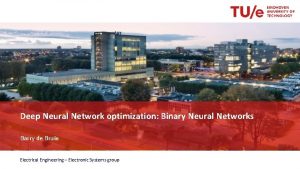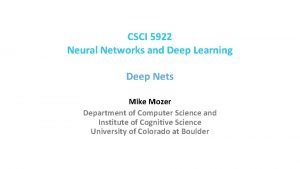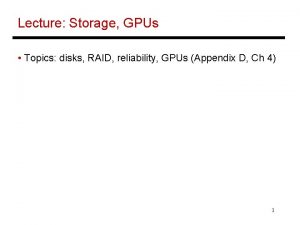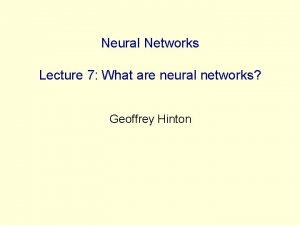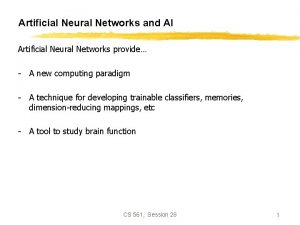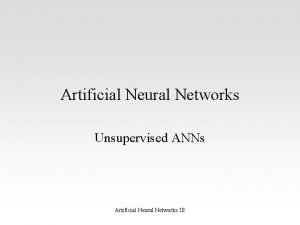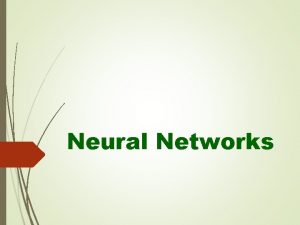Detailed Characterization of Deep Neural Networks on GPUs





















- Slides: 21

Detailed Characterization of Deep Neural Networks on GPUs and FPGAs Aajna Karki, Chethan Palangotu Keshava, Spoorthi Mysore Shivakumar, Joshua Skow, Goutam Madhukeshwar Hegde, Hyeran Jeon Computer Engineering Department San José State University SJSU SAN JOSÉ STATE UNIVERSITY

New Accelerator Design in Deep Learning Era • Deep learning has been rapidly adopted by numerous fields – Health System – Game Design – Personal Assistants – Social Media – Self-navigation vehicles –. . . 2 JOSÉ STATE SJSUSAN UNIVERSITY

New Accelerator Design in Deep Learning Era • To design efficient accelerators for deep learning applications, we should understand the deep learning workloads first – We’ve been using various benchmark suites for this purpose such as SPEC, Rodinia, CUDA-SDK, PARSEC, … for general-purpose architectures 3 JOSÉ STATE SJSUSAN UNIVERSITY

Challenges New Accelerato r • No common workloads that support various accelerators – Most DNN frameworks support only a certain GPU – New accelerators develop their own workloads that are not compatible with other accelerators • Hard to compare performance across accelerators • No common source of workloads that all accelerators can test with 4 JOSÉ STATE SJSUSAN UNIVERSITY

Existing DNN Benchmark Suites • DNNMark – Per-layer computation primitives for DNNs • Baidu Deep. Bench – CNN and RNN core kernels, which internally call DNN library functions • • • Fathom All require proprietary – Tensor. Flow scripts for eight DNN models DNN libraries and different DNN TBD frameworks – DNN training benchmark suite running on Tensor. Flow, MXNet, and CNTK DAWNBench – Can test various hyper-parameters on the models written in Py. Toch and Tensor. Flow 5 JOSÉ STATE SJSUSAN UNIVERSITY

A Light-weight Deep Neural Network Benchmark Suite for Various Accelerators Tango, • Thus, we designed a deep learning benchmark suite, Tango, which supports – Pure CUDA- and Open. CL-based deep neural network computations • Open. CL is supported by various architectures • Tested with CUDA-based GPU devices, GPU architecture simulator, Intel CPU, and Xilinx FPGAs – Five+ most popular convolution neural networks • Alex. Nex, Cifar. Net, Res. Net, Squeeze. Net, VGGNet, Mobile. Net – Two most popular recurrent neural networks • GRU, LSTM – Opensource repository which can be updated easily • https: //gitlab. com/Tango-DNNbench/Tango 6 JOSÉ STATE SJSUSAN UNIVERSITY

A Light-weight Deep Neural Network Benchmark Suite for Various Accelerators Tango, • Tango aims at providing a common testing environment – Such as the other GPU benchmark suites such as Rodinia, CUDA-SDK, ISPASS benchmark suite, and Parboil – That also supports non-CUDA accelerators – Without needing to install DNN frameworks and libraries – With various famous reference networks 7 JOSÉ STATE SJSUSAN UNIVERSITY

To be Frank, Tango Is Not The Only Solution • Since we started this project 2 years ago, there have been a few orthogonal approaches that tackle the same problem – Most of them were pretty recently released – Nov 2018, GPGPU-Sim started supporting cu. DNN (with some limitations) and modified Py. Torch – TVM (OSDI’ 18), Glow (Facebook released in 2019), and Tensor. Flow XLA (2018) compilers generate DNN backend that can be compiled to various architectures machine code – There are some Open. CL DNN libraries (Deep. Cl) – Caffe supports Open. CL for AMD/Intel/Nvidia platforms (under development) 8 JOSÉ STATE SJSUSAN UNIVERSITY

Code Structure (ex. CNN) cat Pre-trained model CUDA/Open. CL Kernels Convolution: Each thread handles one neuron’s convolution function Conv_layer 1 Norm_layer Weight file parser Per-layer Weight, Bias, Hyperparameters Activation: Each thread takes Max(0, convolution result) Pooling_layer Norm: Uses pre-trained model’s Hyper parameters Conv_layer 2. . . Max/Avg Pooling: Each thread takes Max or Avg value out of the given set of data FC_layer 1. . . • One kernel per layer (similar to NN of ISPASS benchmark suite) • Each layer output is checked with the DNN Framework output 9 • Each layer function is implemented by referring to algorithms in papers, and code of Tensor. Flow, Caffe, and Python • CUDA code is converted to Open. CL and then converted to bitstream by using FPGA HLS JOSÉ STATE SJSUSAN UNIVERSITY

Code Snippet (ex. GRU) < reference Tensor. Flow code > < gru_kernel. cu > (https: //www. data-blogger. com/2017/08/27/gru-implementationtensorflow/) 10 JOSÉ STATE SJSUSAN UNIVERSITY

Configurations • Currently supports inference of full-network structures • Pre-trained models are sourced from various repositories – E. g. , caffe model repository, original reference network model, … – Can be replaced if the model follows the original network • Tested with – NVIDIA GPUs (GK 210 and TX 1) & GPU architecture simulator (GPGPU-Sim) – Xilinx FPGA (Pyn. Q) – Intel CPU Network configuration and SRAM usage 11 SJSUSAN JOSÉ STATE Pre-trained models and test inputs UNIVERSITY

Correlation with DNN Framework-based Execution 0, 8 0, 6 0, 4 0, 2 0 Kernel Execution • But, due to model pre-processing and finer-grained kernel execution (a conv layer consists of 15~ kernels) of Caffe, end-to-end execution time is shorter in Tango for the most networks sync 50% not_selected 40% pipe_busy inst_fetch 30% const_mem_dep 20% mem_throt mem_dep 10% exec_dep 0% on v ol in g Total kernel execution time of Tango is longer than Caffe because Tango is not optimized yet texture 60% C • End-to-End Execution other 70% Caffe • Tango Stall cycle breakdown (coalesced in similar type) show similar pattern – 12 FC 1 80% on v ol in g 1, 2 Po Tango Alex. Net C 1, 4 90% FC Caffe Alex. Net 100% Po 1, 6 Stall Cycle Breakdown per Layer Type (Cifar. Net) Relative Execution 1, 8 Conv has more pipeline resource related stalls, Pooling has more data dependency related stalls and FC has more mem related stalls SAN JOSÉ STATE SJSUUNIVERSITY

DNN Characterizations • Obs. 1) Convolution layer is the most timeconsuming layer of CNNs, which may be the best target for optimization • Obs. 2) On-chip cache is helpful for improving the performance of CNNs while the impact of onchip cache for RNNs is negligible 13 JOSÉ STATE SJSUSAN UNIVERSITY

DNN Characterizations • Obs. 3) Stall cycle breakdown is a good indicator of layer types – Fully-connected layers suffer from memory throttling/dependency – Convolution and normalization layers encounter more stalls due to unavailable pipelines – Pooling layers show higher stall rates due to data dependency 14 JOSÉ STATE SJSUSAN UNIVERSITY

DNN Characterizations • Obs. 4) Operation breakdown is a good indicator of CNN and RNN – RNNs use add, ld, mad, and set instructions the most – CNNs also use shl and mul excessively • Obs. 5) Top four mostly executed operations are used for over a half of the entire execution Total operations breakdown used by all networks: Top 10 operations are used for 95% of execution 15 JOSÉ STATE SJSUSAN UNIVERSITY

DNN Characterizations • Obs. 6) Though neural networks are computeintensive workloads, GPU register file is significantly underutilized – Barely use 50% of per-SM register file of NVIDIA Pascal architecture – (This result may be different in the highly optimized kernels) 16 JOSÉ STATE SJSUSAN UNIVERSITY

DNN Characterizations • Obs. 7) Convolution layers have high data locality and hence on-chip memory is mainly useful for optimizing the performance of convolution layers 17 JOSÉ STATE SJSUSAN UNIVERSITY

DNN Characterizations • Obs. 8) In some CNNs, the basic LRR warp scheduler shows better performance than advanced ones – The performance improvement is found especially in conv layers that have high data locality 18 JOSÉ STATE SJSUSAN UNIVERSITY

DNN Characterizations • Obs. 9) FPGA may be faster and energy efficient than GPU for inference. However, the overhead of reconfiguration (e. g. , bitstream downloading on demand) may offset the advantage. Normalized Energy Consumption 2 1, 5 TX 1 1 Pyn. Q 0, 5 0 Cifar. Net Squeeze. Net 19 JOSÉ STATE SJSUSAN UNIVERSITY

Conclusion • We provide a quick evaluation environment that can test various performance metrics of different platforms with a few famous reference DNNs. • Findings – Though individual network structures are different, due to the same core algorithms, the same type networks (CNNs or RNNs) show similar statistics – Individual layer types have unique statistics • Conv suffers from busy pipeline, Pooling has higher data dependency, FC shows higher memory stalls – There are key layers (e. g. , conv) and operations (e. g. , mad, ld, add, shl, mul) that DNNs commonly spend more time, which can be good targets of optimization • We will keep updating the benchmark suite where the researchers can test impact of various optimizations and test more/newer DNNs 20 JOSÉ STATE SJSUSAN UNIVERSITY

Thank you! SJSU SAN JOSÉ STATE UNIVERSITY
 Deep forest: towards an alternative to deep neural networks
Deep forest: towards an alternative to deep neural networks Efficient processing of deep neural networks pdf
Efficient processing of deep neural networks pdf Mippers
Mippers Sql on gpus
Sql on gpus Understanding the efficiency of ray traversal on gpus
Understanding the efficiency of ray traversal on gpus Fast bvh construction on gpus
Fast bvh construction on gpus Analyzing and leveraging decoupled l1 caches in gpus
Analyzing and leveraging decoupled l1 caches in gpus Alternatives to convolutional neural networks
Alternatives to convolutional neural networks Xooutput
Xooutput Least mean square algorithm in neural network
Least mean square algorithm in neural network Neural networks for rf and microwave design
Neural networks for rf and microwave design Visualizing and understanding convolutional networks
Visualizing and understanding convolutional networks Neuraltools neural networks
Neuraltools neural networks Neural networks and learning machines
Neural networks and learning machines On the computational efficiency of training neural networks
On the computational efficiency of training neural networks Convolutional neural networks for visual recognition
Convolutional neural networks for visual recognition Lmu cis
Lmu cis 11-747 neural networks for nlp
11-747 neural networks for nlp Liran szlak
Liran szlak Gated recurrent unit in deep learning
Gated recurrent unit in deep learning The wake-sleep algorithm for unsupervised neural networks
The wake-sleep algorithm for unsupervised neural networks Input layer
Input layer



